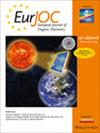Amphiphilic Fluoro-Functionalized Cellulosic Materials: Synthesis, Characterization and Organic Dye Adsorption Properties
IF 2.5
3区 化学
Q2 CHEMISTRY, ORGANIC
引用次数: 0
Abstract
The growing interest towards biopolymers application in amphiphilic conditions prompted us to explore the preparation of fluorinated cellulosic materials. Cellulose (CE) and carboxymethylcellulose (CMC) were functionalized with highly fluorinated pendants, through a nucleophilic aromatic substitution on 3-pentadecafluoroheptyl-5-pentafluorophenyl-1,2,4-oxadiazole (FOX). leading to the corresponding fluorinated biopolymers CE-FOX and CMC-FOX. Structural and thermal stability confirmed covalent attachment of the fluorinated moiety onto the cellulosic skeleton and highlighted an interesting two-dimensional texture of the CMC-FOX material. Hybrid and amphiphilic features of CE-FOX and CMC-FOX, were confirmed by water and oil contact angle measurements (WCA/OCA). Applications as adsorbent material for organic contaminants from an aqueous solution was tested by previously incorporating the functional biopolymer into sodium alginate (SA) hydrogel beads. Rhodamine B (RhB) was used as a model wastewater pollutant. Fluoro-functionalization led to a three- to eightfold increase in the dye-removal efficiency of the SA-incorporated biopolymer with respect to the corresponding non-fluorinated material (from 11% to 48% for SA/CE vs SA/CE-FOX beads and from 11% to 94% for SA/CMC vs SA/CMC-FOX beads). Recyclability tests showed good residual performance of SA/CMC-FOX beads after seven desorption/reuse cycles opening the way to more sustainable adsorbing processes for the removal of emerging pollutants from contaminated water.求助全文
约1分钟内获得全文
求助全文
来源期刊
CiteScore
5.40
自引率
3.60%
发文量
752
审稿时长
1 months
期刊介绍:
The European Journal of Organic Chemistry (2019 ISI Impact Factor 2.889) publishes Full Papers, Communications, and Minireviews from the entire spectrum of synthetic organic, bioorganic and physical-organic chemistry. It is published on behalf of Chemistry Europe, an association of 16 European chemical societies.
The following journals have been merged to form two leading journals, the European Journal of Organic Chemistry and the European Journal of Inorganic Chemistry:
Liebigs Annalen
Bulletin des Sociétés Chimiques Belges
Bulletin de la Société Chimique de France
Gazzetta Chimica Italiana
Recueil des Travaux Chimiques des Pays-Bas
Anales de Química
Chimika Chronika
Revista Portuguesa de Química
ACH—Models in Chemistry
Polish Journal of Chemistry.

 求助内容:
求助内容: 应助结果提醒方式:
应助结果提醒方式:


